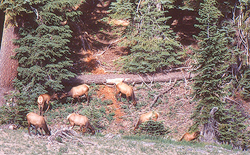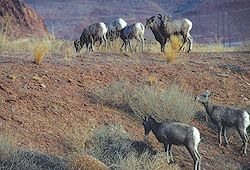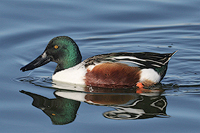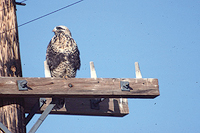NATURE
HAPPENINGS - January 2026 |
|
| Winter Wildlife Viewing
by Damian Fagan |
|
 Winter is an excellent time to view wildlife in the Canyonlands Region. Herds of mule deer, elk, and bighorn sheep congregate on winter ranges where they browse on shrubs and dried grasses. Deer and elk will move down in elevation depending upon snow depth, so look for them on the east side of the La Sals and out in the sagebrush or pinyon-juniper woodlands that blanket the area. Winter is an excellent time to view wildlife in the Canyonlands Region. Herds of mule deer, elk, and bighorn sheep congregate on winter ranges where they browse on shrubs and dried grasses. Deer and elk will move down in elevation depending upon snow depth, so look for them on the east side of the La Sals and out in the sagebrush or pinyon-juniper woodlands that blanket the area. As big ungulates, elk alter their winter diet to include more woody material such as twigs, shoots, bark, evergreen needles, and dried grass. Though this woody forage is lower in quality than their summer diet of fresh grass and forbs, it’s generally available above the snow for them to forage on. Bighorn sheep are the classic desert dwelling animal in this area, as noted on many petroglyph and pictograph panels scattered across the Four Corners. In winter, small bands of sheep may be observed foraging along the Colorado River, in the Potash vicinity, or along the White Rim Trail in Canyonlands National Park. These magnificent animals switch their diet from grasses and forbs to woody shrubs such as antelope bitterbrush, yellow rabbitbrush, willow, and big sagebrush in winter. They will also use their strong hooves to uncover roots to graze on.  Fleet of foot, pronghorn are another species that herd up in winter, often large bands may be viewed along the I-70 corridor between Fruita, Colorado and Green River, Utah. These creatures forage on dried forbs and grasses, cacti, and woody shrubs such as sagebrush which their unique digestive systems can handle better than many other herbivores. Interestingly, a pronghorn’s “spud” process (sniff, paw, urinate, defecate) is evident where small piles of pointed pellets are bordered with paw swipes on the ground. Though this behavior is more associated with the springtime behavior of a male marking his territory to protect breeding or nursing females and fawns in a harem or group. Though smaller mammals such as coyotes, kit foxes, bobcats, and raccoons may be seen during the day, their nocturnal behavior continues in winter. Look for sign of their activity such as tracks or scat which will betray their presence. Consider yourself lucky if you get to see one of these creatures during the day.  Two groups of birds, waterfowl and raptors, are well represented in the region during winter. For waterfowl, the Colorado, Dolores, and San Juan rivers are great areas to see a diversity of species, especially if the weather turns cold and local ponds and lakes freeze forcing the birds to the riverways. Both dabblers (includes mallards, green-winged teal, shovelers, and American wigeons) and divers (includes common goldeneyes, ring-necked ducks, common mergansers, and buffleheads) will be present in the river, along with Canada geese that have either migrated south to the area or are locals. The beautifully patterned wood ducks are dabblers, too, but often considered as “perching ducks” after their unique tree perching habit. On a good day, you could see 12 or 13 species of waterfowl. The raptor group includes hawks, eagles, falcons, and accipiters. Mostly birds of open country, hawks and eagles use their tremendous eyesight to look for prey such as small mammals. Bald eagles will look for carrion in the dry desert areas, but mainly they hunt the rivers and open water for fish and waterfowl. Seeing an eagle snag a fish from the river is a truly incredible sight.  Golden eagles hunt more for small mammals such as prairie dogs, rabbits and jackrabbits, although they will feed on carrion if it’s available. The Cisco Desert along Interstate 70 is an excellent area to look for eagles, hawks, and their prey base in winter. Buteos or the “soaring hawks” include the ubiquitous red-tailed hawk, ferruginous hawk, and rough-legged hawk which winters in the region, while accipiters hunt for birds and small mammals in woodlands, neighborhoods, and riparian areas. The sharp-shinned and Cooper’s hawks are notorious for patrolling residential areas, but an American goshawk (formerly known as the northern goshawk) steals the show when it shows up. Though winter is a quiet season due to the cold temperatures, possibility of ice, and low visitation, it’s an excellent time of year to get out and watch for wildlife in and around Canyon Country.
|
email Moab Happenings
© 2002-2026 Copyright Moab Happenings. All rights reserved.
Reproduction of information contained in this site is expressly prohibited without the written permission of the publisher.
© 2002-2026 Copyright Moab Happenings. All rights reserved.
Reproduction of information contained in this site is expressly prohibited without the written permission of the publisher.

 A natural history writer.
A natural history writer.